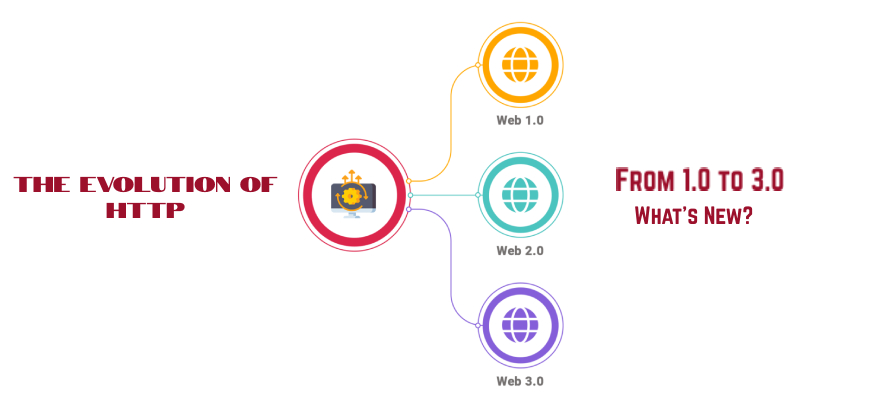HTTP serves as the cornerstone of data exchange across the World Wide Web. Since its inception, it has undergone significant transformations to keep up with the ever-changing demands of the digital landscape. In this blog, we’ll take a journey through the evolution of it, from version 1.0 to the latest 3.0, and explore what’s new in this pivotal protocol upgrade.
Table of Contents
HTTP 1.0: The Beginning
HTTP 1.0, the first official version of the protocol, was introduced in 1996. This early iteration laid the groundwork for web communication. However, it had limitations, particularly in terms of performance and the ability to handle multiple requests efficiently.
What’s New:
Introduced the concept of statelessness.
- In this, the concept of “statelessness” means that each interaction between a client (usually a web browser) and a web server is independent and unrelated to previous interactions.
- When a client makes a request to a server (e.g., to load a web page or retrieve a file), the server processes the request without any knowledge of previous requests from the same client. It doesn’t remember the client’s history or maintain any session information.
- Statelessness simplifies the server’s job and ensures that each request can be processed in isolation, making it easier to scale and manage web servers.
Simple request and response structure.
- It introduced a straightforward request and response structure. When a client (e.g., a web browser) wants to retrieve a web page or resource, it sends a request to the web server.
- The request includes information like the type of request (e.g., GET for retrieving a resource), the requested resource’s location (the URL), and some optional headers.
- The server processes the request and sends a response, which includes the requested data (e.g., a web page) along with response headers and a status code that indicates the success or failure of the request.
Limited ability to keep connections open for multiple requests.
- Connections between clients and servers are, by default, closed after each request and response cycle. This means that for each web page element (e.g., images, scripts, stylesheets), a new connection needs to be established.
- This approach was less efficient in terms of performance because it incurred the overhead of repeatedly establishing connections, which could lead to delays, especially for websites with many resources to load.
HTTP 1.1: Optimization and Persistence
With HTTP 1.1, which arrived in 1997, the protocol underwent significant improvements. This version introduced features aimed at optimizing performance and making better use of persistent connections.
What’s New:
Introduction of Keep-Alive Connections:
- It introduced the concept of “keep-alive” or persistent connections. This means that a single connection between the client (e.g., a web browser) and the server can be used for multiple requests and responses.
- Keep-alive connections reduce the overhead of repeatedly establishing new connections for each resource, making web page loading faster and more efficient.
Pipelining for Multiple Requests:
- It introduced pipelining, allowing the client to send multiple requests to the server without waiting for the responses to the previous requests.
- This concurrency feature improves the efficiency of communication by utilizing the available bandwidth more effectively.
Host Header for Virtual Hosting:
- The “Host” header was introduced in it to support virtual hosting, which allows multiple websites to be hosted on a single web server using the same IP address.
- The Host header tells the server which specific website (host) the client is requesting, enabling the server to serve the correct content.
Enhanced Cache Control:
- Its improved cache control mechanisms, allowing servers to specify how clients should cache and store resources.
- This enhances the efficiency of web page loading by reducing the need to fetch the same resources repeatedly, especially for frequently visited websites.
HTTP/2: A Quantum Leap
HTTP/2, released in 2015, was a game-changer. It addressed many of the performance issues of its predecessors by introducing multiplexing, header compression, and other groundbreaking features.
What’s New:
Multiplexing for Concurrent Requests:
- Its introduced multiplexing, allowing multiple requests and responses to be sent over a single connection simultaneously.
- This concurrent communication significantly improves the efficiency and speed of loading web pages, as it reduces the overhead of establishing multiple connections.
Header Compression for Reduced Overhead:
- HTTP/2 uses header compression to reduce the overhead of transmitting headers with each request and response.
- This reduction in data size leads to faster data transfer and improved web page loading times.
Server Push for Proactively Sending Assets:
- HTTP/2 introduced server push, a feature that allows the server to proactively send resources to the client before the client even requests them.
- This optimizes web page loading by anticipating and providing the necessary assets, enhancing user experience.
Enhanced Security with Mandatory Encryption (HTTPS):
- HTTP/2 encourages enhanced security by making HTTPS (SSL/TLS encryption) mandatory. All communication under HTTP/2 is encrypted by default.
- This mandatory encryption ensures the confidentiality and integrity of data exchanged between clients and servers.
HTTP/3: The Future of Web Protocols
HTTP/3, the most recent and cutting-edge version, is designed to further enhance web performance, particularly for mobile and low-bandwidth connections. It’s built on the QUIC transport protocol, making it faster and more efficient.
What’s New in HTTP/3:
Built on the QUIC Transport Protocol:
- HTTP/3 is built on the QUIC (Quick UDP Internet Connections) transport protocol, which is designed for speed and efficiency.
- QUIC improves data transfer by reducing connection setup times and minimizing latency.
Reduced Latency and Faster Loading Times:
- HTTP/3 is optimized for reduced latency, resulting in faster loading times for web pages and resources.
- This enhancement is especially valuable for mobile and low-bandwidth connections.
Improved Error Correction and Congestion Control:
- HTTP/3 features advanced error correction and congestion control mechanisms.
- These enhancements ensure data is transmitted more reliably, even in challenging network conditions.
Enhanced Security with Encryption by Default:
- Security is a top priority in HTTP/3, with encryption (HTTPS) being the default and mandatory.
- This encryption ensures data privacy and integrity, making it harder for malicious actors to intercept or tamper with web communication.
Conclusion
The evolution of HTTP from version 1.0 to 3.0 represents a remarkable journey in the world of web communication. Each iteration brought new features and optimizations, culminating in the lightning-fast HTTP/3. Embracing the latest version of it is not only about keeping up with technology but also about providing a better user experience in an increasingly demanding online world. As we look to the future, HTTP/3 promises to set new standards in web communication, making the internet even more accessible and efficient for users around the globe.
Seeking an Outcome-Oriented Digital Marketing Firm?
Altis Infonet Pvt Ltd is a Web Development and Digital Marketing company with a focus on client servicing through knowledge-based solutions. Our team of experts will help make your digital dreams come true!





